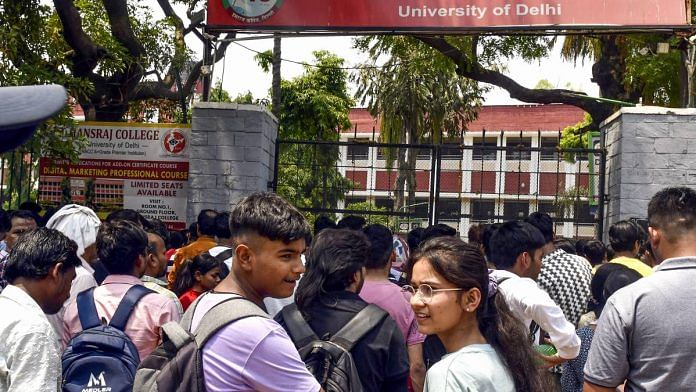New Delhi: The University Grants Commission (UGC) is set to implement several changes to the Common University Entrance Test for Undergraduate Admissions (CUET-UG) next year. These include decrease in total number of subjects in which exam will be conducted, shift to a fully online test format, standardised exam duration, revamp of the general test, and reduction in number of subjects in which students can take the exam from six to five.
These changes are based on recommendations from an expert panel formed to review the CUET for both undergraduate and postgraduate admissions, according to a senior UGC official.
“The committee examined various aspects of the test, including its structure, number of papers, duration, syllabus alignment and logistical challenges before proposing these revisions and seeking further feedback,” UGC chairperson M. Jagadesh Kumar told ThePrint.
The CUET-UG and CUET-PG exams are both conducted by the National Testing Agency (NTA), which is responsible for organising major entrance exams in India. The subsequent Admission process is managed independently by individual universities, which use the CUET scores for their own selection procedures.
Also Read: NIRF parameters ill-designed & lead to absurd university ratings. Govt must order a review
Major changes
Elaborating on the key changes in CUET-UG 2025, Kumar said the exam was undergoing a major overhaul.
“The exam will be fully computer-based, replacing the OMR (Optical Mark Recognition) sheet format, which will streamline the process and enhance standardisation. The total number of subjects will be reduced from 67 to 37, with domain subjects decreasing from 29 to 23. This will help students narrow down their preparation, reduce exam-related stress, and offer them greater flexibility in choosing subjects that align with their interests and career aspirations,” he explained.
Kumar added that all subject papers in CUET-UG 2025 will have a standardised duration of 60 minutes, compared to the previous range of 45 to 60 minutes.
“Fewer subjects and a uniform time limit will create a calmer, fairer testing environment for students, helping to reduce pressure,” he said.
Regarding the reduction in number of subjects, Kumar said the least attempted subjects from previous years had been removed.
“The exam is now more streamlined, focusing on subjects that have higher student interest. This decision was based on extensive data analysis from two cycles. With fewer questions and more time, attempting all questions will now be mandatory, encouraging a deeper understanding and thorough preparation,” he told ThePrint.
Back to online mode
CUET-UG was held in fully online mode in the first two years, i.e. 2022 and 2023.
The first edition was marred by various technical issues, with the exam being cancelled at various locations in the country and getting delayed for over a month. Results were also declared late, affecting the entire academic calendar for universities.
While things were better during the second edition in 2023, technical issues were still reported at some places.
The exam was moved to hybrid mode in 2024 with the test conducted in pen and paper format for 15 subjects having higher registration, including english, history, political science, mathematics, biology, economics, hindi, physics and sociology. For others, it was held in a computer-based format. The idea was to complete the exam early and do away with multiple shifts. However, students reported issues with OMR sheets and answer keys.
Now, the exam will be back in online mode.
Regarding the concerns raised in the first two online editions of CUET-UG, Kumar stated: “We acknowledge the challenges faced in previous editions and are fully committed to ensuring a smooth computer-based experience in 2025.”
“We have taken proactive steps to address the problems encountered earlier, including significant investments to upgrade the digital infrastructure at exam centres nationwide,” he added.
Elaborating on the preparations, he said the UGC and NTA were working on enhancing server capacity, improving internet connectivity and ensuring reliable power backup at all centres.
“Additionally, we are expanding the network of exam centres to ease load on individual sites and provide better access for students. This expansion will also allow for more efficient resource management and technical support,” he explained.
“We are also considering rigorous testing of the exam platform and providing comprehensive training to exam centre staff to ensure they are fully equipped to handle any technical issues. Furthermore, we are strengthening digital infrastructure at rural centres, focusing on reliable internet connectivity and sufficient computer facilities,” the UGC chairperson told ThePrint.
Revamped general test
The general test, a separate section in CUET which assesses general knowledge, logical, and analytical abilities of students, will now be renamed as the General Aptitude Test and will be redesigned, according to Kumar.
So far, the general test was being used by some universities for admission to certain courses.
However, the revamped test will now be used for admission to subjects removed from the CUET-UG list of subjects, including all languages other than the 13 languages of English, Hindi, Assamese, Bengali, Gujarati, Kannada, Malayalam, Marathi, Odia, Punjabi, Tamil, Telugu and Urdu. It will also be used for admission to domain-specific subjects such as entrepreneurship, teaching aptitude, fashion studies, tourism, legal studies and engineering graphics.
No separate subject-specific test will be conducted for subjects in which admission will be done through the general aptitude test.
(Edited by Nida Fatima Siddiqui)
Also Read: DU’s Northeast students’ union fought prejudice with politics—now it’s pulling back at a price






